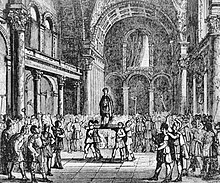AD 360
Appearance
This article needs additional citations for verification. (March 2022) |
| Millennium: | 1st millennium |
|---|---|
| Centuries: | |
| Decades: | |
| Years: |
| AD 360 by topic |
|---|
| Leaders |
| Categories |
| Gregorian calendar | 360 CCCLX |
| Ab urbe condita | 1113 |
| Assyrian calendar | 5110 |
| Balinese saka calendar | 281–282 |
| Bengali calendar | −234 – −233 |
| Berber calendar | 1310 |
| Buddhist calendar | 904 |
| Burmese calendar | −278 |
| Byzantine calendar | 5868–5869 |
| Chinese calendar | 己未年 (Earth Goat) 3057 or 2850 — to — 庚申年 (Metal Monkey) 3058 or 2851 |
| Coptic calendar | 76–77 |
| Discordian calendar | 1526 |
| Ethiopian calendar | 352–353 |
| Hebrew calendar | 4120–4121 |
| Hindu calendars | |
| - Vikram Samvat | 416–417 |
| - Shaka Samvat | 281–282 |
| - Kali Yuga | 3460–3461 |
| Holocene calendar | 10360 |
| Iranian calendar | 262 BP – 261 BP |
| Islamic calendar | 270 BH – 269 BH |
| Javanese calendar | 242–243 |
| Julian calendar | 360 CCCLX |
| Korean calendar | 2693 |
| Minguo calendar | 1552 before ROC 民前1552年 |
| Nanakshahi calendar | −1108 |
| Seleucid era | 671/672 AG |
| Thai solar calendar | 902–903 |
| Tibetan calendar | 阴土羊年 (female Earth-Goat) 486 or 105 or −667 — to — 阳金猴年 (male Iron-Monkey) 487 or 106 or −666 |

Year 360 (CCCLX) was a leap year starting on Saturday of the Julian calendar. At the time, it was known as the Year of the Consulship of Constantius and Iulianus (or, less frequently, year 1113 Ab urbe condita). The denomination 360 for this year has been used since the early medieval period, when the Anno Domini calendar era became the prevalent method in Europe for naming years.
Events
[edit]By place
[edit]Roman Empire
[edit]- February – Julian, Roman Caesar, is proclaimed emperor by the Gallic legions in Lutetia (modern Paris), at the Thermes de Cluny. They refuse to support the eastern campaign against King Shapur II of Persia, and revolt.
- The Alamanni raid Raetia (Switzerland), but are pushed back behind the Rhine by Julian, into the Black Forest.
- King Shapur II continues his campaign against the Roman fortresses, capturing Singara, Bezabde and Nisibis.
- Emperor Constantius II and Julian exchange several letters, both hoping to avoid a civil war.
Europe
[edit]- The Huns invade Europe by the thousands, spreading terror as they take over territories held for generations by Alans, Heruls, Ostrogoths and Visigoths.
Asia
[edit]By topic
[edit]Agriculture
[edit]- Roman authorities in Britain export wheat to supply the legions on the Rhine; they have encouraged production of wheat for that purpose.
Religion
[edit]- Council of Constantinople (360): Emperor Constantius II requests a church council, at Constantinople; both the eastern and western bishops attend the meeting. Ulfilas also attends the council and endorses the resulting creed. After the council several homoiousian bishops are deposed or banished, including Macedonius I of Constantinople and Cyril of Jerusalem.
- At about this date, Ligugé Abbey in France is founded for the monastic Order of Saint Benedict by Martin of Tours, under dispensation from Bishop Hilary of Poitiers.
Births
[edit]- John Cassian, Desert Father and Christian saint (approximate date)
- Saint Mesrob, Armenian monk and theologian (approximate date)
- Saint Ninian, missionary to Scotland (approximate date)
- Tao Sheng, Chinese Buddhist scholar (approximate date)
- Wang Fahui, empress during the Jin Dynasty (d. 380)[1]
Deaths
[edit]

- May 4 – Judas Cyriacus, Roman Catholic priest and saint
- October 14 – Gaudentius of Rimini, Roman Catholic priest and saint
- November 11 – Abramios the Recluse, Byzantine Orthodox priest and saint
- December 18 – Auxentius of Mopsuestia, Byzantine Orthodox priest and saint
Date unknown
[edit]- Eusebius of Emesa, Byzantine Orthodox bishop and saint (b. 290)
- Murong Jun, emperor of the Former Yan (b. 319)
References
[edit]- ^ Urbanization in Early and Medieval China: Gazetteers for the City of Suzhou. University of Washington Press. August 1, 2015. p. 313. ISBN 978-0-295-80610-5.
